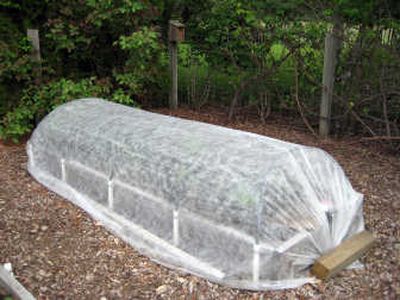Keeping pests out

Last week, we discussed how to deal with deer and birds in the garden. Now we turn to insects and pocket gophers.
I believe that achieving a balance in your garden is the key to having few insect problems. To accomplish this, try a three-pronged approach. Avoid using chemicals that can kill both harmful and beneficial insects, attract birds to your garden because they eat insects, and only treat for problems when they exist. Checking your garden daily is an ideal way to watch for potential problems.
There are several methods for dealing with troublesome insects. Hand-picking works well for Colorado potato beetles and tomato hornworms. Aphids can be dislodged from plants by a blast of water from the hose or sprayed with an insecticidal soap that is safe for humans.
A floating row cover works beautifully as an insect barrier on plants that don’t require pollination. I use it on spinach and Swiss chard to keep the adult form of the leaf miner from laying eggs on the plants. Leaf miners are small worms that tunnel between the layers of cells in the leaves and ruin a crop in short order. Floating row cover also works well for Cole crops – broccoli, Brussels sprouts, cauliflower and cabbage – by preventing the cabbage butterfly from laying eggs on the plants. Those eggs hatch into cabbage loopers, green worms with voracious appetites.
I’ve mentioned the product Bt in previous columns. That’s a strain of bacteria harmless to us but deadly to the larval form of many insects such as cabbage loopers and tomato hornworms. The San Diego strain of Bt targets the larvae of Colorado potato beetles. To prevent corn earworms from getting into ears of corn, apply several drops of mineral oil at the tips of the ears one week after the corn silks appear.
An especially frustrating pest rural gardeners deal with is a rodent called the pocket gopher. They chew on the roots of plants, trees and shrubs, killing them very quickly. We’ve lost fruit trees and large Austrian pines to the little stinkers. In addition to their underground burrows, telltale signs of their presence are mounds of soil.
There are a few ways to deal with pocket gophers, although not all of them are ideal. Garden centers sell gopher traps that work like mouse traps and are very efficient; consult nursery staff to learn more about them. There also are poisonous baits on the market, but those should not be used anywhere near children, pets or edible crops. Some gardeners stick a hose down a gopher tunnel and turn it on full blast in an effort to drown the pests. As someone who has seen their extensive networks of tunnels, I think it mostly causes the gophers to change addresses.
I’ve had good luck with a relatively new product that is safe to use. It contains corn cobs coated with castor oil, a scent that gophers don’t like. It doesn’t kill them, but it successfully chases them from the area. Brand names include Chase, Mole Out and Shake-Away.
It’s true that many critters make gardening a challenge, but dealing with them in an environmentally responsible way is the best solution.
Know before you grow
Before putting up a fight against insects, the first step is to positively identify them. Because so many bugs are beneficial to our gardens, including spiders, green lacewings, lady beetles and their larvae, it’s important to avoid getting rid of the good with the bad. For help with insect identification, visit the Spokane County Master Gardener plant clinic, 222 N. Havana Ave. They can also be reached by phone at (509) 477-2181 or via e-mail at mastergardener@ spokanecounty.org. Kootenai County residents can visit the University of Idaho extension office at 1808 N. Third St., Coeur d’Alene. Call (208) 446-1680 or e-mail Kootenai@uidaho.edu for more information or plant clinic hours.